Water aerobics is a fun and effective way to exercise. It's a great alternative or supplement to working out in the gym or other forms of exercise. It engages the whole body and gets your heart rate up. At the same time, it's a form of exercise that is gentle on the back and joints.
What is Water Aerobics?
Water aerobics is a form of aquatic exercise that focuses on cardio training. The pace is high with powerful movements. You run, jump, kick, and perform many other dynamic exercises in the water. It trains the muscles, the cardiovascular system, and overall body mobility.
In many ways, water aerobics is a gentler form of exercise than land-based gymnastics. This is because you don't carry your own body weight, as the body is supported by the buoyancy of the water. This reliefs and protects the back and joints. Due to the resistance of the water, there is also less risk of sudden or uncontrolled movements that could lead to injuries.
Who can participate in water aerobics?
Everyone can participate in water aerobics, regardless of their age or physical condition. Since the water supports the body, aquatic exercise is suitable for older individuals or for those who are frail or overweight.
It is also good exercise for those who want to engage in intense physical training. The training is versatile and intensive, so you will definitely be able to improve your fitness. Since you encounter resistance from the water in all directions, it is good training for the cardiovascular system, muscles, and mobility.
If you want to train a lot and have a workout program that includes a variety of sports activities, it's a good idea to incorporate water training. This ensures that muscles and joints are stressed in different ways, preventing overtraining. This can help avoid injuries that may result from too much repetitive strain.

How does a water aerobics class take place?
The session begins with a warm-up. Usually, you warm up for about 10 minutes with dynamic movements that involve the whole body. The warm-up always takes place in shallow water.
After the warm-up, you move on to performing water aerobics, which consist of very varied movements. The exercises are mostly done individually, but there may also be exercises in pairs or groups.
In some classes, exercises are also performed in deep water, typically, most of the training takes place in shallow water. The session ends with stretching exercises. The stretching lasts about five minutes and focuses on the major muscle groups.
Water Aerobic exercises
The exercises consist of various types of movement that engage the entire body. These include running and jumping combined with other body movements such as rotational exercises, side bends, back bends, and forward bends. For instance, you can perform star jumps in different directions, kicks knee lifts, and scissor jumps.
In addition, movements are made with the arms and hands. You can scoop the water back and forth with your hands, punch in the water, etc. Sometimes hand weights are also used, or you might pull or push a kick board to increase water resistance.
In some classes, muscle training exercises are used. These usually take place at the edge of the pool, where participants hold onto the edge with their hands or feet. The muscle training consists of exercises for the abdomen, back, arms, thighs, and buttocks. These include leg kicks, leg bends, back pulls, shoulder presses, and push-ups against the edge. You can also perform vigorous swimming movements and splashing exercises.
Examples of water aerobics exercises:
- March while twisting your upper body, first at a normal pace and then gradually faster
- March with your knees lifted as high as possible
- Lift your left knee and right arm while standing on your right leg. Then jump to your left leg while lifting your right arm. Continue alternating jumps from one leg to the other in this way.
- Sit on the kick board and maintain balance by moving your arms in the water. Then you dive under the kick board and pull it down towards you.
The discount code can be used by all new customers on all products on the website, including the products recommended here in the article. What are you waiting for? Get more out of your time in and on the water!
GET A DISCOUNT CODE WITH 10% OFF
The method for water aerobics
Typically, a water aerobics programme is arranged such that there is roughly the same intensity throughout the session. However, there are some forms of water aerobics that are more sports-oriented. Here, there may be shorter periods where exercises are performed at a higher intensity.
The instructor demonstrates all the exercises from the edge of the pool so that everyone can easily see them. The exercises are shown at a slow pace, as they cannot be performed quickly in water. Sometimes, the instructor might also jump into the water to assist or guide.
One often uses a range of equipment in the training, including swim boards, balls, weights, and foam cylinders. The equipment is used both to make the training more enjoyable and to serve as aids or resistance, depending on the nature of the exercise.
Sometimes, the equipment is used for a form of circuit training. Here, participants switch between using different pieces of equipment at set time intervals before moving on to the next one.
Where can you do water aerobics?
In many swimming pools, you can sign up for a water aerobics class. If you live in a smaller town, you might have to travel to a larger city to join a class.
Some holiday centres and water parks also offer water aerobics, so you can exercise together with your family on holiday.
How often and for how long?
Typically, a training session last 45 minutes. Upon enrolling in a class, there is usually one session per week. If you wish to train more frequently, it may be possible at some places to sign up for additional classes. This allows you to attend training sessions two or three days a week. Many people also choose to complement their water workouts with other forms of land-based exercise.
It is a good idea to engage in various forms of exercise to challenge the body in different ways. You can combine water aerobics with any other form of exercise. It depends on your preferences and what you aim to achieve with your training. Generally, it's recommended to elevate your heart rate for 20-30 minutes at least twice a week for overall health benefits.

Shallow or deep water
The most common water depth for water aerobics is between 120 and 150 cm. This means that you exercise while standing in water up to your chest. It's important that the water level is not too low. Otherwise, there will be too little buoyancy, and the shock-absorbing effect of water resistance will be reduced.
Sometimes exercises are combined in both shallow and deep water, involving movement both above and below the water surface. If the training takes place in deep water, one will either float or tread water while performing the exercises. Swimming and diving may also be part of the training in this case.
Usually, however, the training takes place in shallow water where one can easily touch the bottom. So, you shouldn't refrain from joining a class if you can't swim. Typically, you also won't need to submerge your head underwater.
You could potentially inquire with the instructor before signing up if you can't swim or dislike submerging your head underwater. There's also the option to use a swim belt or floaties if the training includes exercises in deep water.
Which equipment does it require?
No special equipment is required for water aerobics, but typically various types of equipment are used in the training.
Often, swim belts and swim boards of various sizes are used. Additionally, elongated foam rollers or foam cylinders of different sizes are utilized, which can be sat or laid on, or pushed around in the water. Furthermore, special gloves resembling swim fins can be used. For muscle training, resistance bands, exercise bands, hand weights, and ankle weights are commonly used.
Additionally, equipment such as balls, hula-hoops, and step benches are used. Poles can also be used, which are pushed off from the pool's bottom, allowing for jumping or swinging in different directions. When training in deep water, swim belts or swim boards are often used.
Which attire is necessary?
When doing water aerobics, you wear regular swimwear. If you're performing exercises underwater, you can also use a swim cap and goggles. If you don't like getting water in your ears or if you're bothered by the noise in the swimming pool, you can optionally use earplugs.
Additionally, it's a good idea to wear pool sandals or water shoes when in the swimming pool. This way, you reduce risk of slipping on the wet tiles, which can be quite slippery.
Music for water aerobics
Water aerobics training usually takes place to music. The music is mainly for motivation because it's almost impossible to follow the rhythm of the exercises. Due to water resistance, you'll be out of sync with the music most of the time.
The music uplifts the mood and provides a more energetic experience. A wide variety of music from different genres is used. Many instructors opt for current popular pop music, selecting tracks with a cheerful and positive vibe. They might also pick old hits from the 80s or 90s. It's up to the instructor to choose the music, so water aerobics music can vary greatly.
Pros and cons of water aerobics
There are many advantages to practising water aerobics. Firstly, it's fun and provides good exercise, and it's gentle on the joints due to water resistance. However, it can also have some disadvantages, especially for those who don't enjoy getting into the cold water.
Pros
- A fun and energizing activity
- Water training is gentle on the back and joints
- Good cardiovascular exercise
- Improves blood circulation
- Increases flexibility
- Enhances endurance and strength
- Alleviates stress and promotes well-being
- Suitable for all ages and physical conditions
Cons
- The water can feel cold
- Some people dislike chlorinated water
- If you're modest, it can be uncomfortable to go from the changing room to the pool in swimwear
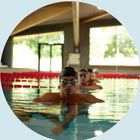

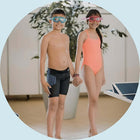
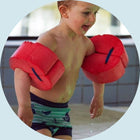
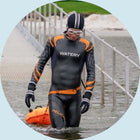
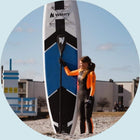
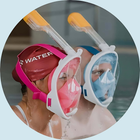


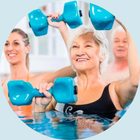
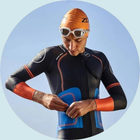
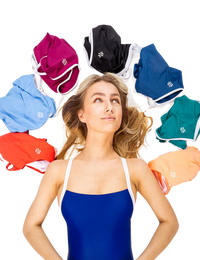
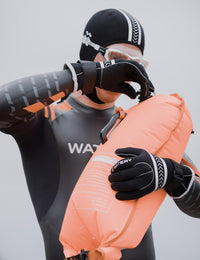
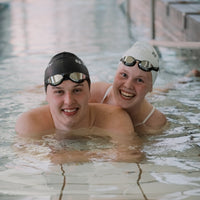












![[FREE GIFT 1] Watery earplugs](http://watery.ie/cdn/shop/files/activeearplugs-blue-1-klartilhjemmeside_1_2_d66304d0-3b01-490e-ac51-8cff659ba150.jpg?v=1768392135&width=200)
![[FREE GIFT 2] Watery Anti-Fog Spray](http://watery.ie/cdn/shop/files/1_8fa9a41d-737d-48b9-8976-59046b5d7f6a.jpg?v=1764791464&width=200)
![[FREE GIFT 3] Watery waterproof mobile case - Storm - Black](http://watery.ie/cdn/shop/files/Designudennavn_16_58bb54e1-1352-48e2-886e-468370189acc.png?v=1768392134&width=200)
![[GRATIS GAVE 4] Watery waterproof bum bag - Talia - Blue](http://watery.ie/cdn/shop/files/WateryTaliaBumBag-Blue_1_5cc1b961-5fe7-49d7-8e3f-f894e48765a4.jpg?v=1768392135&width=200)